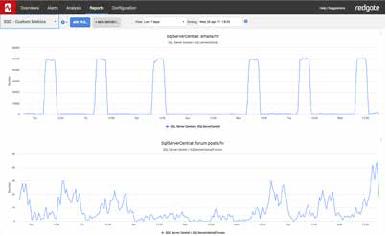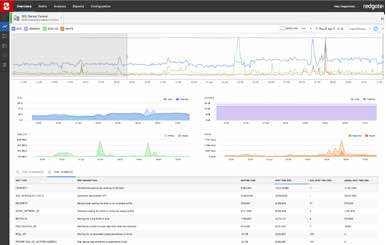Metrics install automatically if you have Redgate Monitor installed.
If you are using Redgate’s SQL Server monitoring tool, Redgate Monitor, you can instantly install and run this metric on your servers.
This metric specifies the total amount of dynamic memory, in kilobytes (KB) the server is using for the dynamic SQL plan cache. It is very similar to the SQL Server: plan cache: cache pages total metric, but instead of providing the size of the dynamic SQL plan cache in kilobytes of memory, it provides very similar data in the form of the number of 8-kilobyte (KB) pages that make up the size of the plan cache.
There is no right or wrong number for this counter. In many instances, the value for this counter won’t change much over time, which is what you would expect on a server with no memory pressure. On the other hand, if you see sudden drops over time for this counter, it might be an indication that the instance is under memory pressure and SQL Server had to reclaim part of the plan cache for other use. Alternatively, rapid increases in this counter may indicate that a large number of one-time use ad hoc queries may have been executed, causing plan cache pollution. This is most often seen shortly after SQL Server has been restarted, and as one-time use ad hoc queries begin to occur, this this counter will increase over time. If this is the case, consider turning on the “optimize for ad hoc workloads” instance-level option to stop plan cache pollution.
Metric definition
Name
SQL Server: memory manager: SQL cache memory (KB)
Description
This metric specifies the total amount of dynamic memory, in kilobytes (KB) the server is using for the dynamic SQL plan cache. It is very similar to the SQL Server: plan cache: cache pages total metric but instead of providing the size of the dynamic SQL plan cache in kilobytes of memory, it gives similar data in the form of the number of 8-kilobyte (KB) pages that make up the size of the plan cache.
There is no right or wrong number for this counter. In many instances, the value won’t change much over time, which is what you would expect on a server with no memory pressure. On the other hand, if you see sudden drops over time for this counter, it might be an indication that the instance is under memory pressure and SQL Server had to reclaim part of the plan cache for other use by SQL Server. The latter would cause this counter to suddenly decrease. Increases in this counter, however, may indicate that a large number of one-time use ad hoc queries may have been executed, causing plan cache pollution. This is most often seen shortly after SQL Server has been restarted, and as one-time use ad hoc queries begin to occur, this counter will increase over time. If this is the case, consider turning on the “optimize for ad hoc workloads” instance-level option to stop plan cache pollution.
The T-SQL query that will collect data
Instances to collect from
Select all
Databases to collect from
master
Collection frequency
60
Use collected or calculated values
Leave the Use a calculated rate of change between collections check box unchecked
Metric collection
Enabled
Alert definition
An alert is not required
 29,039
29,039 
